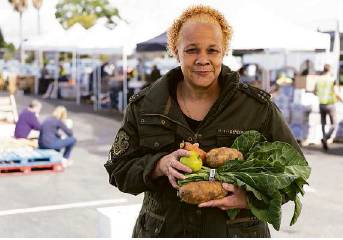Inflation sending needier residents to food banks
By Shwanika Narayan
Chet LeBlanc sat with his windows rolled up in one of three long lines of cars idling in the parking lot of Acts Full Gospel Church in Oakland early Wednesday morning. It was about an hour before doors opened for what had become a three-times-a-week routine for LeBlanc, a 66-year-old resident awaiting physical rather than spiritual nourishment.
“I will go hungry if it weren’t for this help,” LeBlanc said. “I live with my nephew and we both depend on this.”
Since January, the church has acted as the food distribution site for the Alameda County Community Food Bank, which has been experiencing a surge in activity as inflation sends food and gas prices climbing in one of the most expensive regions in the country.
The food bank’s operators say they are serving 28,333 more meals per day this month than they did last month through the church drive-thru and their partner agencies, and are estimating they will serve about 4.7 million meals by the end of April. That’s still well below this time last year, when the food bank distributed 5.4 million meals in April 2021, but also a lot higher than the same period in 2020 or 2019.
“You have more people who may have never identified as food insecure suddenly finding themselves in a precarious situation because of the pandemic, underemployment and unlivable housing costs,” said Mike Altfest, director of community engagement and marketing at the food bank. “The inflation has made it worse.”
On a national scale, consumer prices were 8.5% higher in March than they were a year earlier, reflecting the fastest 12-month inflation rate in more than 40 years, according to the Bureau of Labor Statistics. Grocery store items have risen 10% in the last year, with vegetables, milk and poultry all seeing double-digit percentage hikes compared with a year ago, data from the U.S. Department of Agriculture shows.
In the Bay Area, where a one-bedroom apartment can cost between $3,000 and $5,000 a month and gas prices average $5.70 per gallon, rising inflation is taxing lower-income earners’ ability to afford the basic necessities.
LeBlanc, a former janitor, said he was laid off during the pandemic and that things went from “hard to horribly hard” in the last few months as inflation rose. His nephew has steady employment, but the high cost of living in the Bay Area often leaves LeBlanc feeling helpless, he said.
“Their grocery money isn’t going as far as it used to. Gas prices are high. Many people who come here either depend on us or use it to supplement their meals,” said program coordinator Glenn Hilado as he walked the car line checking in with people before the drive-thru opened.
That Wednesday ended up being the distribution site’s busiest in a year and a half, Altfest said. It was also the day of the week the food bank distributes eggs, a popular item.
The nonprofit food bank now estimates 1 in 4 Alameda County residents are food insecure, compared with 1 in 5 before the pandemic.
Over at Second Harvest of Silicon Valley, the food bank served 470,000 people in San Mateo and Santa Clara counties in March, about 70,000 more than the previous month.
“Anecdotally, we are hearing from clients and from our partners that more people are feeling the pressures of the increased costs of groceries and gas and need some support,” said Diane Baker Hayward, a spokeswoman for Second Harvest.
Hayward added that food is often one of the first areas where people make cuts when money is tight.
Megan McClintock, the logistics coordinator at the Alameda County Community Food Bank’s distribution site, said she was seeing more people line up on foot than drive over the last several weeks. Some who arrive on foot have told her they’d rather walk than drive to save on gas money, she said.
McClintock said the number of guests started to “feel like what we were seeing during the height of the pandemic.”
The Alameda food bank, which is largely privately funded, is feeling the price pinch, too. The price of cabbage has risen from 12 cents to 23 cents a pound, onions from 11 cents to 20 cents a pound, and a dozen eggs up from $1.60 to $2.91 from March to April, according to the nonprofit.
A few cars behind LeBlanc were Rosalina Ocampo, 69, and her husband, Fred Ocampo, 70, who drove up from San Leandro. Both are retired and live with their daughter and two grandchildren.
“As a fixed-income family, what we’re surviving on is just not enough,” Rosalina Ocampo said. “This helps a lot.”
She said they still go to the grocery store and like to give their grandchildren cookies and snacks, but they spend a few more minutes in the aisles considering prices.
“Sometimes we give up spices, which is very hard to do as a Filipino family,” she said. “The food from here lets us not worry too much. Things are hard right now; this helps.”
Phil Dominic, 68, was picking up two boxes for his neighbors, one who didn’t have a car, and another who was in a wheelchair, he said.
“I’m retired and my retirement income is tiny compared to the damning steep rise in the cost of living here,” he said. “If I didn’t own my home (in East Oakland), which I inherited from my mother, I would have been driven out of the Bay Area a very long time ago.”
Shwanika Narayan is a San Francisco Chronicle staff writer. Email: shwanika.narayan@sfchronicle.com Twitter/Instagram: @shwanika

